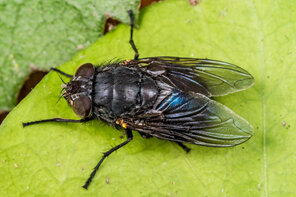
Flystrike is caused by blowflies which lay their eggs on sheep.
Symptoms of the Disease/Condition.
The rapidly growing maggots eat the living flesh of the sheep and poison them through their ammonia secretions.
The 4 species of fly which cause flystrike in NZ are attracted to the moist smelly areas on the fleece. The most common attractants are dags and urine stains in the breech areas and along the back above the shoulders where wool can stay wet for sometime after rain
Affected sheep will not show any signs until there are enough maggots causing enough damage to make the sheep feel uncomfortable. The first signs are a “fidgety sheep nuzzling somewhere on its body”. As the maggot invasion spreads a small area of the fleece becomes blackened with the wound discharges. As the disease progresses the wool starts falling out, sheep stop eating, and seek shade, always fidgeting. Once flystrike has been initiated, further flies are attracted to the site, and the sheep can die from ammonia poisoning 3–6 days from the onset of the first strike.
The Impact.
Flystrike is the most important of all ectoparasite sheep diseases. Flystrike occurs in most areas of NZ but is more common in regions with summer rainfall.
The maggots cause extensive damage which can end up as significant production losses including high death rates. Flystrike is therefore an animal welfare issue as well as an economic one.
Most of the “cost” is associated with the extensive use of chemicals to prevent the disease.
It is estimated:
Following treatment recovery of lost liveweight may take up to 6 weeks
Management and Control.
Farmers have been dealing with flystrike for > 100 years but it is still a major cost to farm business.
Dipping with effective insecticides and using best practice is the most important tool.
The trend towards more friendly chemicals means poor dipping technique is the most common reason for dipping failures.
Tolerance (resistance) to some insecticides has been reported in NZ, and it is likely to become an increasing problem.
There is a wide range of products and application methods available to help treat and prevent flystrike in sheep.
Risk management involves understanding the risk factors, monitoring the fly numbers to assess the risk, and using non-chemical management options to reduce the risk.